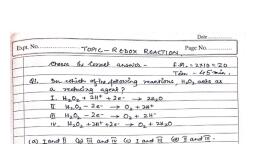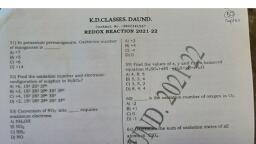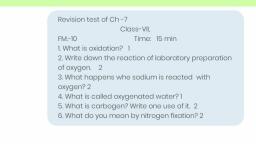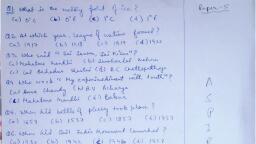Question 2 :
Which of the following behaves as both oxidizing and reducing agents ?<br>
Question 3 :
Out of the halogens, which one is the most powerful oxidizing agent?
Question 5 :
When Carbon monoxide is passed over heated copper oxide it gives :<br/>
Question 7 :
Rusting of iron in the presence of moist oxygen is an oxidation reaction.<br/>
Question 8 :
How many moles of electrons are involved in the reduction of one mole of $MnO^-_4$ ion in alkaline medium to $MnO^-_3$?
Question 10 :
Iron is extracted from iron oxide using carbon monoxide as shown.<br>iron oxide + carbon monoxide $\rightarrow$ iron + carbon dioxide<br>Which statement is correct?
Question 11 :
For the reaction :<br>$ I^- + Cl{ O }_{ 3 }^{ - } + H_2SO_4 \rightarrow Cl^- + HS{ O }_{ 4 }^{ - } + I_2 $<br>
Question 12 :
Which of the following statements is not correct about the given reaction ?<br>$K_4[Fe(CN)_6 \xrightarrow{Oxidation} Fe^{3+} + CO_2 + N{ O }_{ 3 }^{ - }$
Question 15 :
Which of the following species has been oxidized?<br>$Mg(OH)_{2(aq)} + 2Na_{(s)} \rightarrow Mg_{(s)} + 2NaOH_{(aq)}$
Question 16 :
A student places a strip of solid magnesium metal into a beaker full of $100.mL$ of $3.0$ M hydrochloric acid solution. The student observes bubbling and the disappearance of the magnesium metal.<br>Which species is being oxidized and which species is being reduced in this reaction?
Question 18 :
Identify tthe compounds which are reduced and oxidised in the following reaction.<br>$3N_2H_4 + 2Br{ O }_{ 3 }^{ - }\rightarrow 3N_2 + 2Br^- + 6H_2O$
Question 19 :
In the reaction : $Cl_2 + OH^- \rightarrow Cl^- +Cl{ O }_{ 4 }^{ - }+H_2O$ ?<br/>
Question 22 :
In an experiment, 4 g of $M_2O_x$ oxide was reduced to $2.8\ g$ of the metal. If the atomic mass of the metal is $56\, g\, mol^{-1}$. The number of $O-$atoms in the oxide is:
Question 24 :
During the oxidation of arsenite ion, $AsO_{3}^{3-}$, to arsenate ion, $AsO_{4}^{3-}$, in alkaline medium, the number of moles of hydroxide ions consumed per mole of arsenite ion is
Question 25 :
Iodine is formed when KI reacts with a solution of <br>
Question 26 :
Indicate whether the following conversions represent an oxidation, a reduction or none (neither oxidation nor reduction).<br>(i) $HClO_3$ to $HClO_4$ (ii)$ { NH }_{ 4 }^{ + }$ to $NH_3$ <br>(iii) $ NO_2$ to $N_2O_4$ (iv)$ HS{ O }_{ 3 }^{ - }$ to $S{ O }_{ 4 }^{ 2- }$<br>(v) $ H_2O_2$ to $H_2O$
Question 28 :
Which of the following is a non - redox process ?
Question 29 :
Assertion: In a rection $Zn(s)+Cu{SO}_{4}(aq)\rightarrow Zn{SO}_{4}(aq)+Cu(s)$. $Zn$ is a reductant but itself get oxidised
Reason: In a redox rection, oxidant is reduced by accepting electrons and reductant is oxidised by losing electrons
Question 30 :
The oxidation states of metal in the compounds $Fe_{0.94}O$ and $[Cr(PPh_3)_3(CO)_3] $respectively are:



























